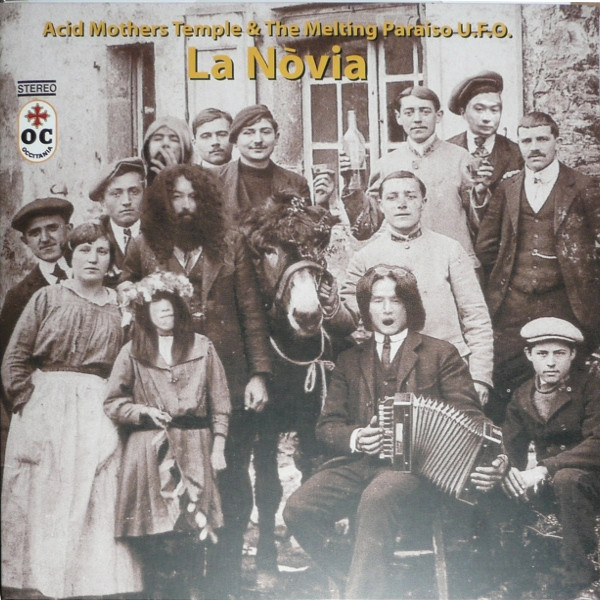.jpg) v/a Lammas Night Laments Vol.1
v/a Lammas Night Laments Vol.1
I saw a copy of this and later volumes in the series while we were out in Kimmage visiting a cat whose owners were away. As a series of CD-Rs compiling weirdo folk tunes they looked very much like my kind of thing, and it was all I could do not to gently slide the discs into my bag and claim ignorance regarding their existence. But they don't call me Honest Ian for nothing, so I left the discs where they lay.
Nevertheless, I did search online for the series to find more information about them, and discovered that information is easily found. The discs seem originally to have been put together from 2005 by some guy called Mark Coyle for a now vanished website called The Unbroken Circle. Since then the series has become much prized by those who take an interest in esoteric folk music. I also discovered that some cursory googling serves up sites from where the collections can be downloaded. Resisting the urge to scoff the lot, I stuck with just the first volume, which I found in what claimed to be a remastered format (implying that previous uploads of the collections have been characterised by poor sound quality).
And it's beautiful stuff. Some old friends (Vashti Bunyan, Dr Strangely Strange, Magnet, & Anne Briggs) and a pile of tunes from people I had at most heard of. Stone Angel's "The Bells of Dunwich" boasts a beautifully clear female vocal,C.O.B.'s "Spirit of Love" is like something from one of those Welsh Rare Beat compilations, for all that it is in English, while Dulcimer's "Caravan" sounds like they lured in Richard Burton to help out with narration.
I will eventually move on to later volumes in the series, but this one makes a great start.
 Acid Mothers Temple & the Melting Paraiso U. F. O. La Nòvia (2000), Vox Bigerri "La Nòvia" (2013)
Acid Mothers Temple & the Melting Paraiso U. F. O. La Nòvia (2000), Vox Bigerri "La Nòvia" (2013)
My beloved and I had the great idea of learning "La Nòvia" for an Unthanks singing weekend: not the full on Acid Mothers Temple throat singing guitar rock freakout version but something closer to its Occitan folk origins. That got me thinking about how I'd like to have versions of this popular tune on my iPod so I could listen to them and stuff. These are both rips from YouTube (I already own a vinyl copy of Acid Mothers Temple's La Nòvia, but it seems to be impossible to legally acquire either a CD or MP3 version of it).
Just in case you do not already know all about this, "La Nòvia" is a folk song from the south of France, sung in the Occitan dialect. I think it may originally have been a children's song or even a lullaby, and it definitely has that kind of repetitive progression children love. The title translates into English as "The Bride" and the lyrics describe her ornamentation, with first verse being thus:
La nòvia qu'a nau brilhants suu cap
La nòvia qu'a nau brilhants suu cap
Nau brilhants suu cap,
L'anèth au dit
Which translates more or less as:
The bride has nine diamonds on her brow
The bride has nine diamonds on her brow
Nine diamonds on her brow
A ring on her finger
Subsequent verses are the same except the number of diamonds reduces by one in each verse until the impoverished bride is left with just one diamond.
If you've ever seen Acid Mothers Temple live you'll know their version, which features throat singing and electric guitar soloing of a type not commonly seen in the mediaeval Languedoc. It also goes on for ages, starting a capella and then bringing in the instruments before looping backwards and forwards between accompanied singing, a capella singing, and pure instrumentation. The Vox Bigerri version is short and unaccompanied, apart from a church bell at the start; on YouTube you see them singing as they walk around a deserted town that may or may not be in the south of France. Their harmonies are pretty full on, but I think they are a vocal folk group so that's not too surprising. The Vox Bigerri version is an impressive showcase of their talents. I would pick up one of their albums if it had a recording of it on it; sadly it does not appear on any of their albums' tracklistings. The Acid Mothers Temple version is however the one I heard first and it will always be my favourite. The original record sleeve contains material on the Cathars, a religious community who lived in the Languedoc until they were exterminated in a thirteenth century crusade; the last two hundred of them were burned at the stake after the conclusion of the siege of Montségur. In the hands and mouths of the Japanese freak rockers the simple children's tune becomes an elegy to the Cathars, whose extermination is symbolic of northern France's subjugation of the Languedoc. With the passage of time it is also en elegiac evocation of a now-vanished phase of Acid Mothers Temple's own history, when their line-up was large and had room for weirdos like Cotton Casino.
images:
Lammas Night Laments (Its lost its found: "VARIOUS ARTISTS - LAMMAS NIGHT LAMENTS VOLUME 01")
La Nòvia (Discogs)
No comments:
Post a Comment